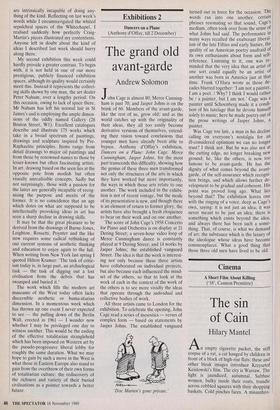Exhibitions 1
Michael Craig-Martin: a Retrospective 1968-1989 (Whitechapel, till 7 January)
Not so funny
Giles Auty
Walking round the retrospective of Michael Craig-Martin's work at the Whitechapel, two unconnected but not entirely irrelevant thoughts struck me. The first was a memory of the expression with which a friend laughingly dismisses both the attempts at humour and lapses into unintended pomposity of her .regular male companion: 'Very witty, sweetie.' Perhaps because Craig-Martin's works so often combine the feebly funny with the vigor- ously pompous — a blend which makes
them irresistible to the curators of modern art museums — they become apt subjects for my good friend's expression.
Modestly, Craig-Martin compares his most notorious work — a simple glass of water on a shelf, cryptically entitled 'An Oak Tree' — with the miracle of transub- stantiation. Indeed, his Whitechapel ex- hibition as a whole casts us back to that terrible, pseudo-philosophical era of the early Seventies when otherwise incoherent art students had only to grunt 'Wittgen- stein' to cause all opposition to flee the field. Craig-Martin's aqueous oak tree and hinged, functionless boxes were part of the so-called minimalist/conceptual cutting- edge which the ambitious modern art historians of the time clutched so avidly to their bosoms. Now the whole gamut of Craig-Martin's often tedious conceits is at last laid out before us: giant agglomera- tions of household objects 'drawn' on the gallery walls in coloured tape; simple demonstrations of first-form physics by means of buckets, strip-lights and milk bottles; venetian blinds, plastic plinths and series of handbag mirrors provided to provoke some kind of solipsist inquiry among those not given previously to intel- lectual pursuits.
Last week, by odd coincidence, I wrote of the ravening appetites of today's mod- ern art historians for half-baked ideas and concepts many of which are impossible to illustrate satisfactorily in visual terms. Often the poor, uninitiated gallery specta- tor is left gaping in wonderment at every- day objects which are supposed to demons- trate this or that complex theory but which Spot the difference: Edward Burne-Jones's pencil study for 'The Tree of Forgiveness' and, below, Michael Craig-Martin's 'On the Shelf, 1970 are intrinsically incapable of doing any- thing of the kind. Reflecting on last week's words while I circumnavigated the whited sepulchral spaces of the Whitechapel, I realised suddenly how perfectly Craig- Martin's pieces illustrated my contentions. Anyone left in doubt about the kind of ideas I described last week should hurry along there.
My second exhibition this week could hardly provide a greater contrast. To begin with, it is not held in one of our more prestigious, publicly financed exhibition spaces, although its quality would certainly merit this. Instead it represents the collect- ing skills shown by one man, the art dealer Peter Nahum, over a lengthy period. On this occasion, owing to lack of space there, Mr Nahum has left his normal lair in St James's and is employing the ample dimen- sions of the oddly named Gallery (28 Bruton .Street, W1). Excellent catalogues describe and illustrate 175 works which take in a broad spectrum of paintings, drawings and sculpture inspired by Pre- Raphaelite principles. Items range from detail drawings to major oil paintings and from those by renowned names to those by lesser-known but often fascinating artists. In art, drawing based on the seen lies at the opposite pole from modish but often visually unrealisable concepts. Sadly but not surprisingly, those with a passion for the latter are generally incapable of recog- nising the purpose and merits of the former. It is no coincidence that an age which dotes on what are supposed to be intellectually provoking ideas in art has seen a sharp decline in drawing skills.
It may be that the great pleasure to be derived from the drawings of Burne-Jones, Leighton, Rossetti, Poynter and the like now requires some radical rethinking of our current systems of aesthetic thinking and education to enjoy again to the full. When writing from New York last spring I quoted Hilton Kramer: 'The task of critic- ism today is, in large part, an archaelogical task — the task of digging out a lost civilisation from the debris that has swamped and buried it.'
The work which fills the modern art museums of the West today often lacks discernible aesthetic or humanitarian dimension. In a momentous week which has thrown up one event I never expected to see — the pulling down of the Berlin Wall, erected in 1961 — I wonder now whether I may be privileged one day to witness another. This would be the ending of the effective totalitarian stranglehold which has been imposed on Western art by the pseudo-progressive liberal lobby for roughly the same duration. What we may hope to gain by such a move in the West is what those in Eastern Europe also stand to gain from the overthrow of their own forms of totalitarian culture: the rediscovery of the richness and variety of their buried civilisations as a pointer towards a better future.



























































 Previous page
Previous page